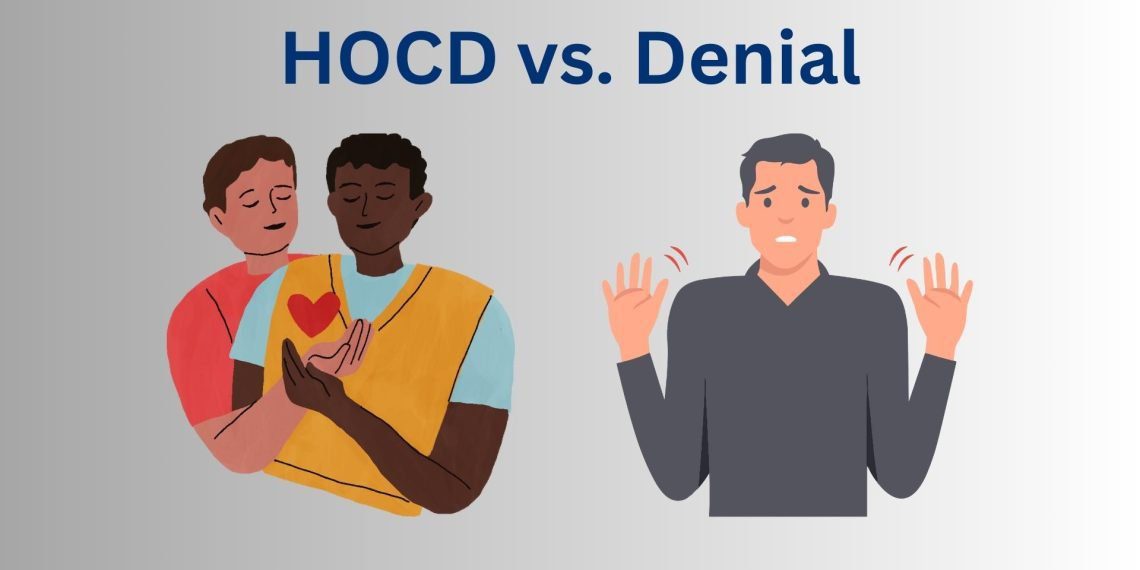Have you ever felt trapped in a constant loop of intrusive thoughts, battling an unshakeable fear that you might be something you’re not? Perhaps you’ve grappled with the horrifying idea that you’re attracted to someone you shouldn’t be, or that you’re harboring harmful intentions. Maybe you’ve dismissed these fears as mere “overthinking,” but a nagging voice inside insists they reflect a deeper truth. This is the essence of Obsessive-Compulsive Disorder (OCD), specifically the form known as Homosexual Obsessive-Compulsive Disorder (HOCD).

Image: knowdifferences.com
Navigating the world of OCD, particularly when it manifests as HOCD, can be disorienting and isolating. Distinguishing between HOCD and simple denial, a critical step in seeking effective treatment, becomes paramount. This article aims to shed light on these complex mental health conditions, offering a roadmap for understanding the difference and ultimately, finding solace and clarity.
Understanding the Labyrinth: HOCD and Denial
At its core, HOCD is an anxiety disorder that manifests as intrusive, distressing thoughts about sexual orientation or attraction. It often involves a fear of being gay, lesbian, or bisexual, even if the individual does not identify as such. Individuals with HOCD might engage in compulsive behaviors like repetitive reassurance-seeking, avoidance, or rituals to quell their anxieties. These anxieties, however, stem from the disorder, not actual desires.
Denial, on the other hand, represents a conscious act of refusing to acknowledge or accept reality. It can be a defense mechanism used to protect oneself from emotional pain, but it often serves as a barrier to progress and healing. With denial, individuals actively suppress or distort facts to avoid confronting unpleasant truths.
The Distinguishing Features
While both HOCD and denial may involve suppressing thoughts and feelings, their underlying mechanisms differ significantly.
HOCD: The Intrusive Nightmare
- Intrusive Thoughts: HOCD is characterized by unwanted, intrusive thoughts that are often violent, bizarre, or simply distressing. These thoughts frequently contradict the individual’s core beliefs and sexual orientation.
- Compulsive Behaviors: To manage anxiety, individuals with HOCD often engage in compulsive rituals, such as repetitive reassurance-seeking, excessive research, or avoidance of certain situations or individuals.
- Discomfort & Distress: Despite the intrusive nature of their thoughts, individuals with HOCD do not actually subscribe to them. They experience significant distress, anxiety, and fear, desperately trying to refute their obsessive thoughts.

Image: allthedifferences.com
Denial: The Protective Shield
- Conscious Suppression: Denial is a conscious act of ignoring or minimizing threatening realities. It involves actively pushing away thoughts and feelings that are deemed unpleasant or unacceptable.
- Lack of Distress: Unlike individuals with HOCD, those in denial may not experience significant distress or anxiety. They may rationalize their behaviors and avoid confronting uncomfortable truths.
- Self-Preservation: Denial can be a defense mechanism against overwhelming emotions or facing painful realities. It can provide temporary relief from psychological distress, but ultimately hinders personal growth and healing.
The Path to Clarity: Seeking Professional Help
Differentiating between HOCD and denial is crucial for effective intervention. Seeking help from qualified mental health professionals like therapists or psychiatrists specializing in OCD is essential. They can provide accurate diagnoses, develop tailored treatment plans, and offer invaluable support along the journey of recovery.
Treatment and Healing: Breaking Free from the Cycle
Treatment for HOCD often involves a combination of therapies, including Cognitive Behavioral Therapy (CBT) and Exposure and Response Prevention (ERP). CBT aims to help individuals identify and challenge the irrational thoughts fueling their anxiety, while ERP involves gradually exposing them to their fears in a safe and controlled environment, allowing them to learn that their fears are unfounded.
Hocd Vs Denial
The Journey of Acceptance
Understanding HOCD and its distinction from denial paves the way for authentic self-discovery and personal growth. It’s important to remember that everyone’s journey is unique, and there is no single solution. With perseverance, support, and the right professional guidance, individuals with HOCD can navigate their anxieties, break free from the cycle of obsessive thoughts, and ultimately embrace a life filled with authenticity and self-acceptance.





